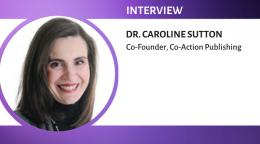Open access initiatives and challenges from a society publisher’s perspective: Interview with Stacey Burke

Democratizing knowledge through open access to research involves building and maintaining systems that support this goal. It also involves collaborating with multiple stakeholders and engaging with or educating researchers—who can find open access publishing a complex process. Publishers play a central and crucial role in this transformation to an open access world.
So, to gain insights into some of the challenges faced and progress made with these efforts, we invited views from Stacey Burke, Publications Director of Digital, Marketing & Library Relations at the American Physiological Society (APS).
Could you tell us about yourself and the work that you do at APS?
In my role at the APS, I have the opportunity to promote the exellent work of our authors in the Society’s 16 distinguished scientific journals dedicated to the advancement of physiological research, which has formed the basis for many biomedical advances. I also guide potential authors on how publishing their work wth APS publications can help them Publish with Purpose to strengthen the community of like-minded scientists that are solving major problems affecting life and health.
Using our most visible line of communication, our digital platform journals.physiology.org, we support our community by spotlighting exceptional scientific discoveries. Working with libraries ties it all together by giving global users access to APS content and, in recent years, partnering to ensure their researchers are compliant with funder requirements. We explore seamless options to provide our authors compliance through transformative agreements, like APS’ Read Publish & Join, and investigate future OA business models to enable broader OA impact, like Subscribe to Open—all activities that rely heavily on our library partners.
The proportion of research papers published open access is increasing each year but not at the pace expected. What are some gaps in the existing open access publishing infrastructures that need to be addressed to accelerate progress?
As a not-for-profit society and on the board of Society Publishers Coalition, I participate in many conversations with learned societies that are daunted by the substantial financial impacts and infrastructure changes required to implement OA at scale. This is due to either limited resources, both human and financial, or—from my partner-published colleagues—a lack of control or influence.
Proper workflows and data integration is critical to ensure that an author publishes OA seamlessly. This requires coordinated and sophisticated crosstalk from systems and heavy involvement from internal departments. Unfortunately, this is not always symbiotic and takes a lot of agile iterations to get to the right solution. Often uncontrolled by the non-profit publisher that does not have its own systems, we rely on the development of external submission and peer review systems, productions systems, and hosting platforms to create affordable solutions that meet the needs of many.
From your interactions with researchers, what insights have you gained on OA-specific challenges and gaps? Have you observed any noteworthy demographic differences?
In the past few years, researchers are gaining awareness of what OA means to their publishing output and funding. However, there remain a lot of misconceptions and a lack of prioritization to publish their work open access. While our European colleagues have been under policy changes implemented by their funders for years, the open access evolution just hit its peak in the U.S. in 2022, when the White House Office of Science and Technology (OSTP) announced that all federally funded research must be available for free immediately upon publication. US researchers are paying attention to the implications of this announcement and how they can remain compliant when they publish their work.
That said, I think many authors are still unsure why publishers like APS are making their ORCID IDs mandatory at submission, or why they need to pick the correct ROR ID to align with their institution, and why entering funder information is so important to the publication process. These are the questions that publishers need to collect to report compliance in the metadata landscape and fully support implementation of policy requirements.
What are some initiatives driven by APS to streamline OA publishing and support researchers? Can you discuss the key learnings from these efforts?
APS is responsible for educating our community on open access and the impact these announcements, like the OSTP recommendation, have on our researchers’ publishing efforts. As we engaged our members and authors in discussions of OA, we knew we had to work on eliminating misunderstandings of OA and saw the market need to better understand the benefits of publishing their work OA. We responded by launching our OA Webpage to educate them on the options APS can deliver in our hybrid journals and our two fully open access journals—Function and Physiological Reports. APS also held a series of OA webinars to discuss the benefits of publishing, including What Researchers Need to Know Now and Open Access Opens Doors—Do Researchers Have the Keys?
As for streamlining the process, APS was fortunate to launch one Read, Publish and Join pilot with Iowa State University Library in 2020, which gave us the time to work our way from a manual workflow to a more automated process, making it easy for our authors to publish under transformative agreements. This included working with our vendors such as the implementation of dropdown fields allowing for authors to align with their institutions through ROR IDs that flow into articles’ metadata. We also engaged our internal APS IT to ensure proper integration into our society’s systems for proper billing exclusions and membership initiation as part of the “Join” under our Read, Publish & Join pilot.
All these changes were necessary to take the burden off of our authors and provide an easy solution to comply with their funders and publish OA with APS. This paved the way for APS to expand our efforts to Jisc—the U.K. education and technology not-for-profit—offering U.K. institutions unlimited, immediate open access publishing in the APS Journals Digital Library.
More recently, we discussed Unlocking Open Access…what will this mean for researchers and publishers? in our member communication, The Physiologist Magazine. APS Chief Publication Officer, Colette E. Bean, MA, informed our members of our ongoing efforts to aid our community and the work underway: “APS’ publishing portfolio is going to need to evolve as a part of the changes that we’re seeing,” she says. “We’re working in a very focused way to ensure the long-term sustainability of the program and of the Society. We are committed to continuing to serve our members and authors while enabling the transformation to open access that is going to occur in the next several years.”
What role do you see community-driven open access models playing in the goal of making all research fully and immediately free to access by anyone?
I think there is already great movement happening in community-driven environments, standards being established and collaborative system advancements, with more on the horizon.
The OA Switchboard, to which we are launching customers, provides a central metadata exchange hub and essential infrastructure to facilitate the fulfilment of open access strategies across business models, policies, and agreements for all stakeholders—funders, institutions, and publishers.
CrossRef created the open source Open Funder Registry, which is a registry of persistent identifiers for global grant organizations to allow for proper transparency into research funding and its outcomes.
As referenced earlier, ROR is a global, community-led registry of open persistent identifiers for research organizations, which APS uses to enable publishing OA under transformative agreements. But more is in the works!
UK Research and Innovation (UKRI), a non-departmental public body of the Government of the United Kingdom that directs research and innovation funding, commissioned MoreBrains Cooperative to develop a roadmap for improvements to the open access research information landscape, engaging all stakeholders in the ecosystem. In July 2023, the National Information Standards Organization (NISO) formed a Working Group to develop a Recommended Practice for operationalizing open access (OA) business processes. The Subscribe to Open Communities of Practice (S2O) offers a space for publishers and librarians to connect on experiences and learn about this new innovative model.
I, for one, am excited to see what other key collaborations will present itself to help publishers of all shapes and sizes navigate an open access future.
Comments
You're looking to give wings to your academic career and publication journey. We like that!
Why don't we give you complete access! Create a free account and get unlimited access to all resources & a vibrant researcher community.

Subscribe to Journal Selection
After writing a research paper, the next step is to find the right journal to publish it. Subscribe and get curated content to find the perfect journal that will give impetus to your research paper and your career.












